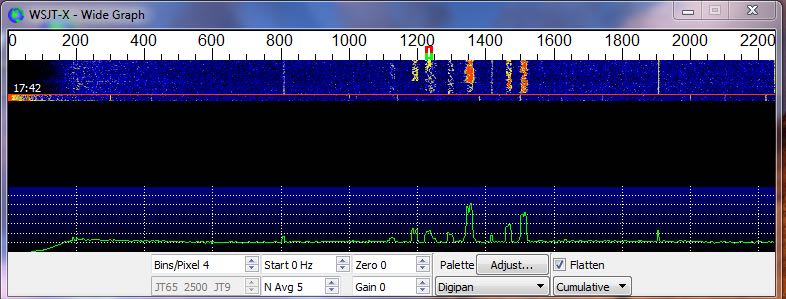Many thanks to SWLing Post contributor, Patricia, who writes with the following inquiry:
I wonder if anyone has heard and identified the station or signal I heard on 7075 kHz at 0745 October 30, 2021 on my C. Crane Skywave, and I live in southern California. I would like to know where this signal originates, sounding something like a numbers station, no voice, but a whooshing sound. I have heard it may be a ham frequency or a signal from space. Any ideas?
Thanks,
Patricia G.
Thank you for your question, Patricia.
I believe what you’re hearing is the ham radio digital mode called FT8.
FT8 is a weak signal digital mode that is extremely popular in the ham radio world these days. The mode isn’t designed around relaying lengthy messages, rather it’s designed for short, very formulaic exchanges.
Each message of up to 13 characters takes 13 seconds to send. For FT8 operators to be successful, they try to keep very accurate timing on their computing device controlling the transceiver. When the whole group is coordinated well, you’ll hear groups of signal tones singing all at once in 13 second intervals with a couple seconds of space between messages.
Here’s what FT8 sounds like in SSB mode:
It’s possible it sounded quite different, however, if you were listening in AM mode.
If this doesn’t sound like what you heard, perhaps you can check the comments for any other possibilities, but my guess is it’s FT8 as it’s a pretty strong chorus of tones!
Great question, Patricia!


Ask and ye shall receive:
https://www.sigidwiki.com/wiki/FT8
It is a very weak signal mode capable of being decoded below the noise ideally, and much less than CW. EACH line is a single signal so you are seeing multiple stations there. Since 40m is a popular band you are bound to see a lot of signals there; it’s also a good way to see if the band is open at all (as beacons).
Speaking of which you should also see the related (and newer) FT4 as well as WSPR itself (although its 40m sub-band starts at 7036kc). Also related modes are the JTx modes.
Hope this helps!
Bonjour oui il s’agit bien du FT8. sur 7075 khz . Je n’aime pas ce mode numérique !!!!!!!
ils est très polluant !!! ………………S73 de Lionel F11CKA/ swl
FT8 is the sound of one computer talking to another computer.
Thank you. So you are saying that FT8 is a combined signal, not just from one location?
Yes, this is correct. FT8 is a “protocol” or “system” in which users around the world have chosen to use that frequency (in the 40m band) to communicate with one another. You are hearing all kinds of Ham operators’ computers talking to each other, each transmitting from its own location.
FT8 is what I believe is being heard on 7075kHz, as well. On the USA East, I hear most of that 40M activity from 7070kHz to 7075kHz. Hey… When you heard that, this can tell you that the band is open to somewhere. Oh BTW, on many HF HAM Bands, at XX070kHz portion is pretty much where FT8 is, like on 80M, 20M, and so on.
Might also be Winliink, an email protocol for hams to use. One of the frequencies used is 7075.9 khz. The newish VARA version uses up to 52 very skinny slices of narrow (500 hz) or wide (2300 hz) bandwidth and I suppose could sound like a blended digital sound like whooshing. I hope to start using it myself soon to see how it works.
Just a possibility. There are a lot of digital modes now in use in the Data range of frequencies of the 40 meter band. Shortwave is definitely NOT dead!
This segment is for FT8 specifically according to the international gentleman’s agreement for the mode (I think this is one of the segments that FT8 took over from Hellschreiber but I could be wrong).
What you are describing is OFDM which is easy to spot because the “slices” are very close together and, together on SSB audio, sounds like “whooshing” as you say, or to me like a weird howling winter wind.
FWIW, OFDM is what pretty much every radio tech above medium wave or so has settled on: all mobile cell phone standards 3G+, WiFi, most modern digital broadcast standards (DRM, DVB, & ATSC 3.0), most modern STANAG modes (which is where VARA was probably derived from), etc. It provides the best Bits/Hertz ratio of anything we have today and has some other advantages especially in the multiplexing department (back to cell phones & WiFi).
The WSJT modes (FTx, JTx, WSPR, etc) are pretty much the exact opposite: attempting to use the absolute minimum bandwidth & shift combined with advanced DSP-decoding and (especially with the FT modes) outright cheating (yeah, I said it) to achieve detection below the apparent noise floor, beating QRSS (super slow speed) CW. It is because the modes are so popular that you could mistake them (particularly during contests) for OFDM but just listening on SSB with your ears will tell you what it really is if you can’t tell on the waterfall.
I’m studying for my general, and FT8 is one of the questions – hearing it in reality is a great way to remember how it works. In the late 60s I was stationed with the Army in Viet Nam and we worked on TTY (Teletype FSK) signals, packets and even secure telephones – which were early digital phones. The FT8 system makes perfect sense as it seems to go along with the other data transmission systems.